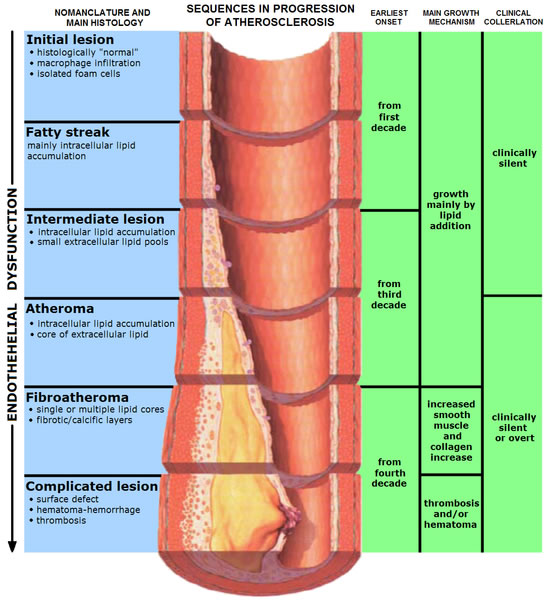Activity 19.3.2 – Selecting foods to reduce the threat of cardiovascular disease
 More than half of American adults die from some form of cardiovascular disease (heart failure, aneurysms, strokes, etc.) in which the heart and/or blood vessels fail to function properly. The underlying cause for many cardiovascular conditions is atherosclerosis ("hardening of the arteries"). In atherosclerosis, fats accumulate on the inner walls of vessels, reducing their flexibility and restricting blood flow. As a result of increased resistance, the heart generates greater pressure to insure that oxygen and nutrients get to all tissues of the body. Unfortunately, this extra stress on the heart can cause it to wear out faster. Excessively high blood pressure may cause vessels to "balloon" at points of weakness. Such enlargements are known as aneurysms and may burst and lead to substantial internal bleeding. Finally, atherosclerosis may stimulate the formation of blood clots. Such clots cause the death of tissues when they block blood flow. Clots in the brain cause strokes and those in the coronary artery cause heart attacks.
More than half of American adults die from some form of cardiovascular disease (heart failure, aneurysms, strokes, etc.) in which the heart and/or blood vessels fail to function properly. The underlying cause for many cardiovascular conditions is atherosclerosis ("hardening of the arteries"). In atherosclerosis, fats accumulate on the inner walls of vessels, reducing their flexibility and restricting blood flow. As a result of increased resistance, the heart generates greater pressure to insure that oxygen and nutrients get to all tissues of the body. Unfortunately, this extra stress on the heart can cause it to wear out faster. Excessively high blood pressure may cause vessels to "balloon" at points of weakness. Such enlargements are known as aneurysms and may burst and lead to substantial internal bleeding. Finally, atherosclerosis may stimulate the formation of blood clots. Such clots cause the death of tissues when they block blood flow. Clots in the brain cause strokes and those in the coronary artery cause heart attacks.
Fortunately, we know dietary risk factors associated with cardiovascular disease and can reduce the risk by minimizing certain foods in our diets. Many physicians recommend their patients substitute polyunsaturated for saturated fats (increase unsaturated:saturated ratio), reduce sodium intake, and minimize cholesterol. Determine foods that should be minimized or eliminated to reduce the risk of cardiovascular disease. Nutrition database.
(1) (a) Define a new category (insert column) for the ratio of saturated/unsaturated fat. Define the first cell as the ratio of saturated fat to unsaturated fat for that record (divide the saturated fat cell by the unsaturated fat cell) and copy this formula relatively (to reflect the contents of each record) to all other records in the column (figure 19.6). Perform a filter (record selection) for foods with a saturated to unsaturated fat ratio greater than or equal to 3.0. (b) Perform a filter (record selection) for foods with a sodium content greater than 100 mg/serving. (c) Perform a filter (record selection) for foods with cholesterol greater than 10 mg/serving size. Include a printout of the foods that exceed all three criteria. These foods should be minimized or eliminated in diets of those who are at risk of cardiovascular disease. What are these foods? To return to the full list, show all records before proceeding with another activity.
